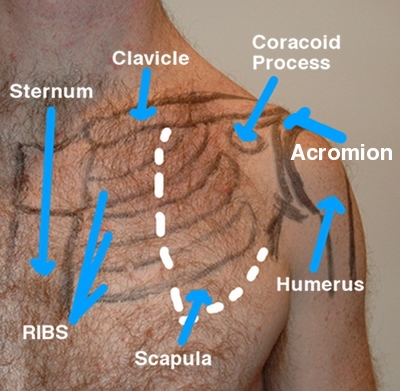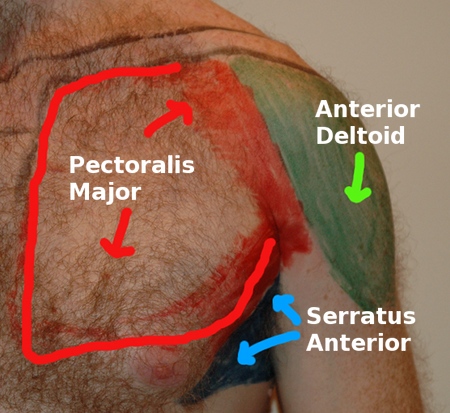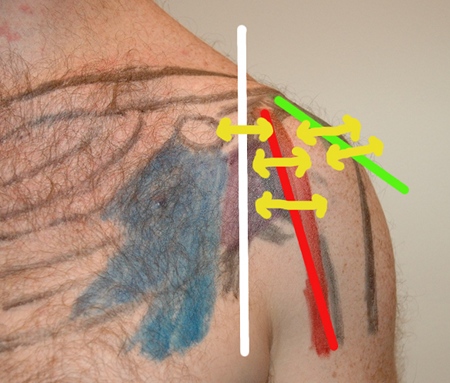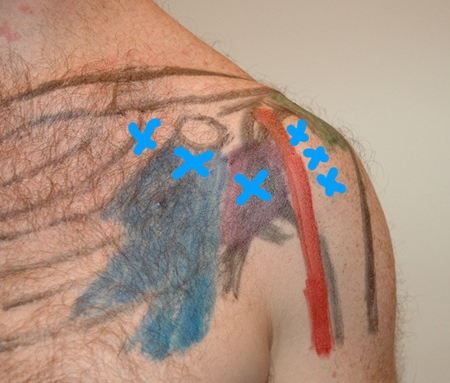Self Muscle Massage pt 14- Anterior Shoulder
This is part fourteen in the Self Muscle Massage Series. In the introduction post to this series we introduced and demonstrated the three muscle release techniques that will be used in this post. If you would like to review them, click here. If you would like to see any other parts of the series, click here.
In this installment of the series we’re going to be moving from the back of the shoulder around to the front and side. Traditionally, the shoulder is considered the least stable joint in the body. Like the hip, the shoulder is a ball and socket joint. However, unlike the hip which is supported by the large muscles of the hip and thigh, the shoulder has only the small rotator cuff muscles, deltoid, and inter-scapular muscles. This means two things: 1) that the shoulder is a very mobile joint (it can move in six different directions) and 2) it is a very common site of injury.
Anatomy
Bony Landmarks
In your reading, you may have heard of something called the “shoulder girdle”. This is composed of three bones: the scapula, the clavicle, and the humerus. The scapula lays on the back of the rib cage (it is held in place by muscle) and connects to the clavicle/collar bone which wraps around from your breast bone/sternum. These two bones meet on the outside of the shoulder at the acromion (this is the bony bump on the outside of your shoulder). Just beneath the acromion is where the humerus (upper arm bone) attaches to the shoulder blade (the ball or head of the humerus connects to a socket in the scapula known as the glenohumeral fossa). Part of the reason it is referred to as the shoulder girdle versus simply the shoulder joint is because there are actually three joints- 1) where the scapula and the clavicle/collar bone meet at the acromion (this is your AC joint), 2) the glenohumeral joint where the humerus connects to the scapula, and 3) the sternoclavicular or SC Joint where the clavicle attaches to front of the rib cage at the sternum.
When working on the front of the shoulder, there are four major landmarks you should know:
#1 The sternum (commonly called the breast bone). The sternum is the innermost border when you are working on this area. This is where the ribs connect in the front of your chest before wrapping around to connect to your spine in the back. In addition to being the inner border, the sternum is also where the clavicle starts.
#2 The clavicle (aka the collar bone). The clavicle is one of the most frequently fractured ones in the body. This is because it is the only bone that directly connects the shoulder and arm to the rest of the skeleton. Large impacts to the arm secondary to falls can easily overload this small bone resulting in fractures. The clavicle is part of two separate joints, one at either end. When working on the front of the shoulder, consider this your upper border.
#3 Humerus. The humerus is the large bone of the upper arm. It travels from the elbow up to the shoulder where it connects to the scapula at the glenohumeral fossa (the humerus is the ball and the scapula is the socket). A unique feature of the humerus is the ball portion (also known as the head of the humerus). It is lined with grooves and tunnels where the rotator cuff and bicep/tricep muscle tendons travel through and attach. It is important to note that as your lift your arm, the head of the humerus rotates down to allow the longer shaft of the bone to travel without hitting the acromion process. In the event of injury or swelling, it is possible for this space to be decreased (a common injury referred to as Impingement).
#4 Scapula. Think of the shoulder blade like a bony triangle that sits on the back of the rib cage and is held in place by muscle. The most prominent feature of the shoulder blade is the large bony ridge that runs across the back of it. This is known as the spine of the scapula. If you reach over your shoulder with your fingers, this bony ridge will be easy to feel. The most prominent feature on the front is the coracoid process which is bony bump that the pec muscles attach to. To find this process, trace your fingers along your clavicle until you feel it curve back just before it gets to the outside of the shoulder. From here drop your fingers down approx 1 inch and press in. Pull your shoulder blades back together and then round your shoulder forward. You will feel a bony bump push forward. This is the coracoid.
Muscles
Deep Layer
#1 Pec Minor. This is the smaller of the two pectoral muscles. It originates on the ribs and angles up to attach to the coracoid process.
#2 Biceps (Long Head) Tendon. The bicep muscle has two tendons, one for the long head and one for the short head. The long head is unique in that it allows the bicep to move not only the elbow but also the shoulder joint. The short head can only move the elbow joint. The long tendon has its own groove in the head of the humerus and is a common site for tendonitis and inflammation. It is frequently confused with rotator cuff tendonitis, but is actually closer to the chest while the rotator cuff (supraspinatus in particular) is closer to the outside of the shoulder. To find this tendon, place your hand over the front of your shoulder. With your elbow against your side, bend and straighten your elbow. As you do so, you will be able to feel the bicep tendon move beneath your fingers.
#3 Supraspinatus (part of the rotator cuff). Like the Bicep described above, in the front of the shoulder the rotator cuff tendons sneak through from where they originate on the back of the shoulder blade. The most commonly injured tendon is the supraspinatus (see the post on the back of the shoulder for pictures and more info). As it sneaks through to the front you can find it. Start by finding the bicep tendon that move your fingers just past it towards the outside of the shoulder. With your elbow at your side, rotate your arm in/out. You will feel the supraspinatus tendon move beneath your fingers as your do so.
#4 Subscapularis (part of the rotator cuff). The subscap muscle is the only part of the rotator cuff that starts on the inside of the shoulder blade. From there it inserts onto the front of the humerus and assists in rotating the arm in (like you’re trying to reach behind your back). This muscle is deep in the arm pit.
#5 Serratus Anterior. Like the subscap muscle, the serratus originates on the inner surface of the shoulder blade and wraps around to attach to ribs 1-9 underneath the arm/armpit. These attachments allow the serratus to lift the scapula, pull it tight against the rib cage (known as protraction- this motion would occur if you were trying to punch your arm forward with the arm out straight in front of you) and rotate it upwards. To find this muscle, lift your arm up to shoulder height and reach around underneath your arm with your other hand. From here, punch that arm forward. The lower part of the muscle will be easier to feel.
Superficial Layer
#1 Pectoralis Major. This muscle is easily identified by most people. It covers the entire chest as two muscles, one on each side. It starts on the clavicle and sternum and inserts on the upper humerus. This muscle pulls the humerus in to the body, helps lift the shoulder up into flexion (over head with the arm in front of you), and protracts the shoulder blade (pulls it against the ribcage).
#2 Anterior Deltoid. This muscle is the large tear drop muscle that drapes over the entire shoulder. Due to it’s size it is traditionally broken up into three parts (anterior, middle and posterior). All three originate on the humerus. The anterior portion of the muscle then moves to insert along the clavicle. This muscle works to lift the arm out to the side (abduct), into internal rotation (reaching behind the back), and into flexion (pulling the arm straight up in front of you). Palpation of this muscle is easy. Just place your hand on your other shoulder and lift the arm out to the side. The deltoid will be the large muscle beneath your hand. You will be able to trace the front part forward to the clavicle.
Soft Tissue Release
What you’ll need: stick/foam roller and tennis ball
The techniques: click here for an introduction to the techniques and a video demonstration
1) Lengthening/elongation with the foam roller or stick.
2) Cross friction with your hand or tennis ball.
3) Sustained pressure or trigger point release with the tennis ball.
Key Areas to Work On
#1 Foam Roller. When working on the front of the shoulder, start by loosening up the larger and more superficial muscles. Position the roller vertically at the front of your shoulder and start by working on the pectoralis muscles as a whole. You may find that this area is very tender. If so, try using a raised surface versus actually laying on the roller itself. A bed or table works best. This way you can directly control the pressure you are using and can work your way up to laying on the roller. From here position the roller in your arm pit to better target the smaller, deeper muscles where they sneak through from the shoulder blade to the humerus (you will want your arm position up over head with palm facing up towards the ceiling). Start by rotating or rolling forward and back in this position and work your way up to actually rolling from shoulder to rib cage (this will be very tender and may take some time to work up to!). Rotating forward over the roller will target the front of the shoulder best.
#2 Tennis Ball- Cross Friction. The key with cross friction is to remember that you are working perpendicular to the muscle fibers. This means that you will be working either up/down or horizontally (front/back) depending on where you are in front of the shoulder. The movement itself is very small (maybe 1-2 inches). Sink the tennis ball in deep, relax and then maintain that depth as you work. If you feel like the ball is rolling or sliding, you’re moving too much. When working on the front of the shoulder, the primary location for trigger point work will be along the pec muscles or along the anterior deltoid. Standing will be the easiest for this area and both techniques are demonstrated in the video. If you’re still unsure of the cross friction technique and how to properly do it, click here for a review.
Key areas for cross friction will be:
1) The biceps tendon itself. Start high and work your way down.
2) The supraspinatus tendon.
3) The strip in between the two tendons.
4) The intersection spot in the middle (white line). See video for how to find the intersection.
5) The pec muscles. For these muscles you will want to work to the inside of the intersection and in an up/down direction versus the yellow forward/back pictured above.
#3 Tennis Ball- Trigger Point. When moving onto trigger point areas, remember, let the tennis ball sink in nice and deep and just sit on it. If after 2-3 minutes it hasn’t released, move onto the next spot!
Key trigger point areas include:
1) The upper pec below the clavicle
2) Just below the coracoid process
3) The intersection at the front of the shoulder (see video for a description on how to find this area)
4) The space in between the biceps and supraspinatus tendons.
Video
Here is a video demonstration for using these techniques on the front of the shoulder.
References
1) Hammer, Warren. (2007). Functional Soft-Tissue Examination and Treatment by Manual Methods, 3rd edition. Jones and Bartlett Publishers, Inc, Sudbury, MA.
2) Hyde, Thomas and Gengenbach, Marianne. (2007). Conservative Management of Sports Injuries, 2nd edition. Jones and Bartlett Publishers, Inc, Sudbury, MA.
3) Moore, Keith and Dalley, Arthur. (1999). Clinically Oriented Anatomy, 4th edition. Lippincott Williams and Wilkins, Baltimore, MD.
4) Muscolino, Joseph. (2009). The Muscle and Bone Palpation Manual. Mosby, Inc, St. Louis, MO.


















incredeble information and great tools for athletes who want to stay healthy….